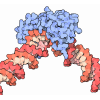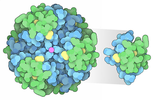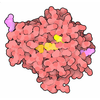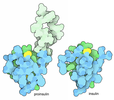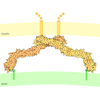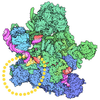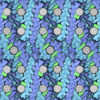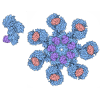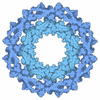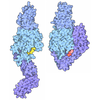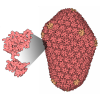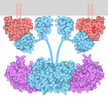+ Open data
Open data
- Basic information
Basic information
| Entry | Database: PDB / ID: 9qpq | ||||||||||||||||||
|---|---|---|---|---|---|---|---|---|---|---|---|---|---|---|---|---|---|---|---|
| Title | The structure of the COPI leaf bound to GOLPH3 | ||||||||||||||||||
 Components Components |
| ||||||||||||||||||
 Keywords Keywords | STRUCTURAL PROTEIN / COPI coated vesicles / GOLPH3 / Golgi transport / vesicular transport | ||||||||||||||||||
| Function / homology |  Function and homology information Function and homology informationasymmetric Golgi ribbon formation / protein targeting to Golgi apparatus / cargo adaptor activity / cerebellar Purkinje cell layer maturation / protein localization to axon / protein localization to cell leading edge / Golgi vesicle budding / COPI-coated vesicle / pancreatic juice secretion / Golgi cisterna ...asymmetric Golgi ribbon formation / protein targeting to Golgi apparatus / cargo adaptor activity / cerebellar Purkinje cell layer maturation / protein localization to axon / protein localization to cell leading edge / Golgi vesicle budding / COPI-coated vesicle / pancreatic juice secretion / Golgi cisterna / cellular response to rapamycin / mitotic cleavage furrow ingression / trans-Golgi Network Vesicle Budding / COPI-mediated anterograde transport / COPI vesicle coat / glycoprotein biosynthetic process / protein retention in Golgi apparatus / Glycosphingolipid transport / Golgi vesicle transport / regulation of receptor internalization / Intra-Golgi traffic / COPI-dependent Golgi-to-ER retrograde traffic / regulation of Arp2/3 complex-mediated actin nucleation / Golgi ribbon formation / organelle transport along microtubule / Synthesis of PIPs at the Golgi membrane / establishment of Golgi localization / cell adhesion molecule production / leukocyte tethering or rolling / intra-Golgi vesicle-mediated transport / Nef Mediated CD4 Down-regulation / retrograde vesicle-mediated transport, Golgi to endoplasmic reticulum / Golgi to plasma membrane protein transport / dendritic spine organization / phosphatidylinositol-4-phosphate binding / regulation of mitochondrion organization / long-term synaptic depression / lamellipodium assembly / COPI-dependent Golgi-to-ER retrograde traffic / Golgi cisterna membrane / Lysosome Vesicle Biogenesis / Golgi Associated Vesicle Biogenesis / pigmentation / endoplasmic reticulum-Golgi intermediate compartment / Golgi organization / Synthesis of PIPs at the plasma membrane / cell leading edge / protein secretion / intracellular copper ion homeostasis / positive regulation of TOR signaling / endoplasmic reticulum to Golgi vesicle-mediated transport / COPI-mediated anterograde transport / vesicle-mediated transport / Neutrophil degranulation / MHC class II antigen presentation / Gene and protein expression by JAK-STAT signaling after Interleukin-12 stimulation / sarcomere / small monomeric GTPase / adult locomotory behavior / positive regulation of protein secretion / intracellular protein transport / trans-Golgi network / establishment of localization in cell / hormone activity / cellular response to virus / mitochondrial intermembrane space / cell migration / protein transport / growth cone / gene expression / endosome / neuron projection / postsynaptic density / protein domain specific binding / Golgi membrane / axon / focal adhesion / neuronal cell body / intracellular membrane-bounded organelle / GTPase activity / mRNA binding / negative regulation of apoptotic process / GTP binding / structural molecule activity / enzyme binding / magnesium ion binding / endoplasmic reticulum / Golgi apparatus / protein-containing complex / mitochondrion / extracellular space / RNA binding / extracellular exosome / plasma membrane / cytosol / cytoplasm Similarity search - Function | ||||||||||||||||||
| Biological species |  Homo sapiens (human) Homo sapiens (human) | ||||||||||||||||||
| Method | ELECTRON MICROSCOPY / subtomogram averaging / cryo EM / Resolution: 7.5 Å | ||||||||||||||||||
 Authors Authors | Taylor, R.J. / Tagiltsev, G. / Ciazynska, K.A. / Briggs, J.A.G. | ||||||||||||||||||
| Funding support |  Germany, Germany,  United Kingdom, European Union, 5items United Kingdom, European Union, 5items
| ||||||||||||||||||
 Citation Citation |  Journal: Sci Adv / Year: 2025 Journal: Sci Adv / Year: 2025Title: The mechanistic basis of cargo selection during Golgi maturation. Authors: Rebecca J Taylor / Nikita Zubkov / Katarzyna A Ciazynska / Jonathan G G Kaufman / Grigory Tagiltsev / David J Owen / John A G Briggs / Sean Munro /   Abstract: The multiple cisternae of the Golgi apparatus contain resident membrane proteins crucial for lipid and protein glycosylation. How Golgi residents remain in their designated compartments despite a ...The multiple cisternae of the Golgi apparatus contain resident membrane proteins crucial for lipid and protein glycosylation. How Golgi residents remain in their designated compartments despite a constant flow of secretory cargo is incompletely understood. Here, we determine the structure of the COPI vesicle coat containing GOLPH3, an adaptor protein that binds the cytosolic tails of many Golgi residents. Analysis of this structure, together with structure-guided mutagenesis and functional assays, reveals how GOLPH3 uses coincidence detection of COPI and lipids to engage Golgi residents preferentially at late cisternae. Our findings rationalize the logic of cisternal maturation and explain how COPI can engage different types of substrates in different Golgi cisternae to retrieve some proteins back to the ER while retaining others within the Golgi apparatus. | ||||||||||||||||||
| History |
|
- Structure visualization
Structure visualization
| Structure viewer | Molecule:  Molmil Molmil Jmol/JSmol Jmol/JSmol |
|---|
- Downloads & links
Downloads & links
- Download
Download
| PDBx/mmCIF format |  9qpq.cif.gz 9qpq.cif.gz | 714.1 KB | Display |  PDBx/mmCIF format PDBx/mmCIF format |
|---|---|---|---|---|
| PDB format |  pdb9qpq.ent.gz pdb9qpq.ent.gz | 394.9 KB | Display |  PDB format PDB format |
| PDBx/mmJSON format |  9qpq.json.gz 9qpq.json.gz | Tree view |  PDBx/mmJSON format PDBx/mmJSON format | |
| Others |  Other downloads Other downloads |
-Validation report
| Summary document |  9qpq_validation.pdf.gz 9qpq_validation.pdf.gz | 1.5 MB | Display |  wwPDB validaton report wwPDB validaton report |
|---|---|---|---|---|
| Full document |  9qpq_full_validation.pdf.gz 9qpq_full_validation.pdf.gz | 1.5 MB | Display | |
| Data in XML |  9qpq_validation.xml.gz 9qpq_validation.xml.gz | 85.8 KB | Display | |
| Data in CIF |  9qpq_validation.cif.gz 9qpq_validation.cif.gz | 148.2 KB | Display | |
| Arichive directory |  https://data.pdbj.org/pub/pdb/validation_reports/qp/9qpq https://data.pdbj.org/pub/pdb/validation_reports/qp/9qpq ftp://data.pdbj.org/pub/pdb/validation_reports/qp/9qpq ftp://data.pdbj.org/pub/pdb/validation_reports/qp/9qpq | HTTPS FTP |
-Related structure data
| Related structure data |  53278MC M: map data used to model this data C: citing same article ( |
|---|---|
| Similar structure data | Similarity search - Function & homology  F&H Search F&H Search |
- Links
Links
- Assembly
Assembly
| Deposited unit | 
|
|---|---|
| 1 |
|
- Components
Components
-Protein , 2 types, 5 molecules ABRST
| #1: Protein | Mass: 33859.555 Da / Num. of mol.: 2 Source method: isolated from a genetically manipulated source Source: (gene. exp.)  Homo sapiens (human) / Gene: GOLPH3, GPP34 / Production host: Homo sapiens (human) / Gene: GOLPH3, GPP34 / Production host:  #8: Protein | Mass: 20721.742 Da / Num. of mol.: 3 Source method: isolated from a genetically manipulated source Source: (gene. exp.)  Homo sapiens (human) / Gene: ARF1 / Production host: Homo sapiens (human) / Gene: ARF1 / Production host:  |
|---|
-Coatomer subunit ... , 6 types, 13 molecules DEFGHIJKLMNOP
| #2: Protein | Mass: 138617.672 Da / Num. of mol.: 2 Source method: isolated from a genetically manipulated source Source: (gene. exp.)   Trichoplusia ni (cabbage looper) / Strain (production host): High Five / References: UniProt: Q8CIE6 Trichoplusia ni (cabbage looper) / Strain (production host): High Five / References: UniProt: Q8CIE6#3: Protein | Mass: 102566.078 Da / Num. of mol.: 2 Source method: isolated from a genetically manipulated source Source: (gene. exp.)   Trichoplusia ni (cabbage looper) / References: UniProt: O55029 Trichoplusia ni (cabbage looper) / References: UniProt: O55029#4: Protein | Mass: 107197.961 Da / Num. of mol.: 4 Source method: isolated from a genetically manipulated source Source: (gene. exp.)   Trichoplusia ni (cabbage looper) / References: UniProt: Q9JIF7 Trichoplusia ni (cabbage looper) / References: UniProt: Q9JIF7#5: Protein | | Mass: 57304.250 Da / Num. of mol.: 1 Source method: isolated from a genetically manipulated source Source: (gene. exp.)   Trichoplusia ni (cabbage looper) / References: UniProt: Q5XJY5 Trichoplusia ni (cabbage looper) / References: UniProt: Q5XJY5#6: Protein | Mass: 97622.703 Da / Num. of mol.: 3 Source method: isolated from a genetically manipulated source Source: (gene. exp.)   Trichoplusia ni (cabbage looper) / References: UniProt: Q9QZE5 Trichoplusia ni (cabbage looper) / References: UniProt: Q9QZE5#7: Protein | | Mass: 20218.168 Da / Num. of mol.: 1 Source method: isolated from a genetically manipulated source Source: (gene. exp.)   Trichoplusia ni (cabbage looper) / References: UniProt: P61924 Trichoplusia ni (cabbage looper) / References: UniProt: P61924 |
|---|
-Details
| Has protein modification | N |
|---|
-Experimental details
-Experiment
| Experiment | Method: ELECTRON MICROSCOPY |
|---|---|
| EM experiment | Aggregation state: PARTICLE / 3D reconstruction method: subtomogram averaging |
- Sample preparation
Sample preparation
| Component |
| ||||||||||||||||||||||||||||||
|---|---|---|---|---|---|---|---|---|---|---|---|---|---|---|---|---|---|---|---|---|---|---|---|---|---|---|---|---|---|---|---|
| Molecular weight |
| ||||||||||||||||||||||||||||||
| Source (natural) |
| ||||||||||||||||||||||||||||||
| Source (recombinant) |
| ||||||||||||||||||||||||||||||
| Buffer solution | pH: 7.2 | ||||||||||||||||||||||||||||||
| Buffer component |
| ||||||||||||||||||||||||||||||
| Specimen | Embedding applied: NO / Shadowing applied: NO / Staining applied: NO / Vitrification applied: YES Details: Budded and budding COPI vesicles were reconstituted by mixing liposomes with purified COPI coat protein, Arf1, GTPgammaS, and GOLPH3. | ||||||||||||||||||||||||||||||
| Specimen support | Grid material: COPPER / Grid mesh size: 300 divisions/in. / Grid type: C-flat-2/2 | ||||||||||||||||||||||||||||||
| Vitrification | Instrument: LEICA EM CPC / Cryogen name: ETHANE-PROPANE / Humidity: 100 % / Chamber temperature: 293 K |
- Electron microscopy imaging
Electron microscopy imaging
| Experimental equipment |  Model: Titan Krios / Image courtesy: FEI Company |
|---|---|
| Microscopy | Model: TFS KRIOS |
| Electron gun | Electron source:  FIELD EMISSION GUN / Accelerating voltage: 300 kV / Illumination mode: FLOOD BEAM FIELD EMISSION GUN / Accelerating voltage: 300 kV / Illumination mode: FLOOD BEAM |
| Electron lens | Mode: BRIGHT FIELD / Nominal magnification: 53000 X / Nominal defocus max: 3500 nm / Nominal defocus min: 1500 nm / Cs: 2.7 mm / C2 aperture diameter: 50 µm |
| Specimen holder | Cryogen: NITROGEN / Specimen holder model: FEI TITAN KRIOS AUTOGRID HOLDER |
| Image recording | Electron dose: 3.114 e/Å2 / Avg electron dose per subtomogram: 125 e/Å2 / Film or detector model: GATAN K3 BIOQUANTUM (6k x 4k) / Num. of real images: 1 |
- Processing
Processing
| EM software |
| |||||||||||||||||||||||||||||||||||||||||||||
|---|---|---|---|---|---|---|---|---|---|---|---|---|---|---|---|---|---|---|---|---|---|---|---|---|---|---|---|---|---|---|---|---|---|---|---|---|---|---|---|---|---|---|---|---|---|---|
| CTF correction | Type: PHASE FLIPPING AND AMPLITUDE CORRECTION | |||||||||||||||||||||||||||||||||||||||||||||
| Symmetry | Point symmetry: C1 (asymmetric) | |||||||||||||||||||||||||||||||||||||||||||||
| 3D reconstruction | Resolution: 7.5 Å / Resolution method: FSC 0.143 CUT-OFF / Num. of particles: 108432 / Symmetry type: POINT | |||||||||||||||||||||||||||||||||||||||||||||
| EM volume selection | Details: A total of 4866 COPI vesicles and buds were manually picked from 206 tomograms in UCSF Chimera. The center of each coated vesicle or bud was picked and radii were assigned using a custom- ...Details: A total of 4866 COPI vesicles and buds were manually picked from 206 tomograms in UCSF Chimera. The center of each coated vesicle or bud was picked and radii were assigned using a custom-written plugin (https://www.biochem.mpg.de/7940000/Pick-Particle). Initial coordinates for subsequent particle search were seeded with an even spacing of 10.9 nm (8 pixels in tomograms binned 8 times) perpendicular to the sphere surface, and with random in-plane rotation, yielding a total of 193104 particles (C3). Num. of tomograms: 206 / Num. of volumes extracted: 193104 / Reference model: EMDB-2985 | |||||||||||||||||||||||||||||||||||||||||||||
| Atomic model building | B value: 200 / Protocol: RIGID BODY FIT | |||||||||||||||||||||||||||||||||||||||||||||
| Atomic model building | 3D fitting-ID: 1 / Source name: AlphaFold / Type: in silico model
|
 Movie
Movie Controller
Controller



 PDBj
PDBj

